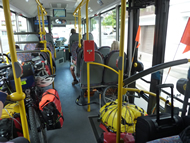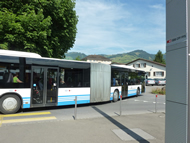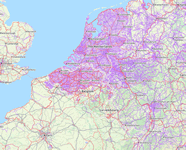


| < - > Facilitate effort — Itineraries — Guiding — Equipments — Paradises — Preparations — Health — Sitemap — Contact |
PARADISES FOR CYCLO-HIKING (Europ)
So far we have practiced cycling in France of course, but also in seven other European countries.
This has led us to note the enormous differences in the integration of bicycles, and of cycle tourism in particular, depending on the country. Some are paradises, others are far from it. Here is a short summary.
THE PARADISES
CYCLO-HIKING IN WEST OF GERMANY (formerly RFG)
Germans are historically nature lovers. Ecology (real, lived ecology, not political ecology as in France) is well established in Germany.
They are accustomed to physical activities that are fun "Outdoor". Since the 19th century they have been practising the weekend "Volksmarsch" (popular walks) on a massive scale.
With the revival of the bicycle in the 80-90s, they took over the 2-wheeler. Cycling is generalized whatever the age group, social class… etc.
This practice:
- Start at a young age. See the toddler bikes with small gear changes!
- Is general in everyday life. You should see the crowded bike parks in front of the big shops!
- Goes naturally to the holiday activities in bicycle tourism.
- The choice of bike types is extraordinary. Even the older ones can continue to practice :
- difficulty to step over, here is an ultra-low profile frame;
- lack of balance, here is a tricycle… etc.
- Public transport (trains, subways, trams…) are very often accessible to bicycles.
In short, cycling is in the German culture. Therefore, as everyone is a practising cyclist… everyone :
- Respect the cyclists.
- Requires infrastructure.
All this is obvious when hiking in Germany (formerly West Germany):
- Cars don't graze or overtake until they can do so comfortably.
- If a traffic blunder is made by surprise or inadvertently, motorists will stop dead on the spot and let the bicycle pass without honking their horns or grumbling.
- On cycle paths where mopeds are allowed, mopeds everywhere respect the speed limit of 30km/h that is imposed on them in this context.
- There are countless cycle paths for everyday life and for cycle tourism, with breathtaking continuity and safety.
- If there are works, even for a few hours, that encroach on a cycle path then there is always a safe solution :
- protected temporary encroachment on the roadway
- signposted detour as for motorways detours in France
Contrary to France with its badly educated dogs running around, the dogs are calm and very well trained. When approaching a bicycle, the master only has to say a word calmly, the dog immediately goes to bed and lets the bicycle pass quietly… impressive, always and everywhere !!!
Well, let's stop here the dithyrambe and move on to the other countries.
CYCLO-HIKING IN SWITZERLAND
Switzerland is multilingual and multicultural.
Fortunately, German culture permeates the whole country, even the French-speaking part of Switzerland.
As a result, Switzerland has almost all the qualities described above for Germany.
Wonderful cyclo-tours.
The railway network is remarkably dense with a high frequency of service. Bicycles are accepted on almost all trains. However, beware of prices which are quite high.
Fantastic bicycle service… even in the event of breakdowns or work on the trains, bicycles are accepted in the replacement buses. Example in 2014, very heavily loaded (with trailer for camping), we are accepted in a bus… Inconceivable with the SNCF!
Contrary to what one might think, the TCS (Touring-Club-Switzerland) campsites are absolutely not a reference. They are often less well-equipped and more expensive than others, and some of them are badly frequented (Gypsies in Luzern).
THE ALMOST PARADISE
CYCLO-HIKING IN HOLLAND
In 2009, during our cyclo-trip on the Rhine, we had been unpleasantly surprised by Holland. On the other hand, during our ride on the Meuse, in 2020, we were very satisfied. Why this difference?
It's true that technically Holland beats all other countries on a level:
- A large number of cycle paths, often wide. Always in perfect condition, very well maintained.
- Bicycle parks everywhere.
- A daily use superior to any other.
What surprised us in 2009, and remains true in 2020, it's a variable geometry respect of car-driver towards cyclists:
- As long as you're on a bike path, motorists respect you 100%. If the bike path has priority when crossing a street or road, cars always stop without ever trying to force their way through.
- On the other hand, as soon as you ride outside a bike path, you are the annoying person who has to be careful in your own little corner.
There is no minimum distance for cars to follow when overtaking a bicycle. Motorists have no patience when they are behind you. So they overtake even when brushing past in a frightening way, and this in town as well as on the road, so no matter how fast they are going !!!
If you bother a car that much, you get horned or even insulted.
Fortunately on the Meuse, in 2020, the regions through which we pedal are particularly protective of cyclists. Indeed, almost all the towns and villages we pass through are limited to 30 km/h. Even better, all the small connecting roads between cycle paths are limited OUTSIDE THE TOWNS (in the countryside) to 60 km/h. This has been great. We were able to hike in peace and quiet.
As in Germany, mopeds are allowed on certain cycle paths. In Germany they are limited to 30 km/h, so that's cool. In Holland, however, the limit is 60 km/h. Which is a lot on a cycle path! So you can be overtaken very closely (and therefore dangerously) by mopeds and scooters on even narrow cycle paths. What's more, young people are less respectful than their elders… so some of them ride faster than 60 km/h!
Another good surprise 2020, on our itineraries we passed through many small woods or forests. It's incredible (especially for us coming from under-equipped France), parallel to the forest roads there was ALWAYS a cycle path… well maintained! Great.
In addition, pedestrians never invade the cycle paths. And just like in Germany the dogs are very well trained (they have REAL masters), so the dogs are calm and are never aggressive or annoying for bicycles.
In short, Holland deserves to be a cycling paradise in many ways. But the behaviour of motorists is not up to the standard of a complete paradise.
CYCLO-HIKING IN BELGIUM
In 2020, we quickly passed through Belgium. For the first time through Wallonia, along the Meuse to Holland. Then on our way back from Holland we drove along the Flemish coast of the North Sea.
We were able to measure the enormous difference between these 2 Belgian regions.
Roughly speaking, Wallonia is equipped like France (very little) and Flanders like Holland (a lot).
This can be easily confirmed by taking a look at the map opposite, taken from the OpenStreetMap cycling map.
Moreover, the facilities in Wallonia are poorly maintained.
But what makes cycling particularly attractive in Belgium as a whole (Wallonia and Flanders together) is the respectful behaviour of motorists. This is even better than in Germany, and yet it is an excellent reference. It is really safe to ride there.
CYCLO-HIKING IN SCANDINAVIA
There are many national cycle paths in Denmark, fewer in Sweden (except Malmö and Stockholm) and very few in Finland (except Helsinki).
The Scandinavians are cautious in their cars and generally respect cyclists. However, there is a small downside for the Swedes and a big one for the Danes. In these 2 countries cars overtake at a good distance when the road is very wide. On the other hand, too often, the cars brush past when they have to pass a car. Therefore, in these 2 countries, we use one of our favourite tactics: when we see (in the rear-view mirror) that a car is likely to pass another one while overtaking us, then, and before the rear car catches up with us, we zigzag to make it look like we are not in control of our trajectory. It's infallible, before this risk drivers brake and wait wisely behind us before overtaking us. In Finland drivers wait wisely behind without needing to do so.
Campsites are of VERY different quality depending on the country:
- In Denmark, where wild camping is strictly forbidden, there are many VERY well-equipped campsites.
- In Sweden the campsites are generally OK with some rudimentary exceptions.
- In Finland the campsites are few in number, poorly equipped and the few facilities are too often dirty and/or broken.
Very tempted by Norway, we studied the routes and accommodation. It is a VERY relief country. Even along the North Sea, the cumulative positive difference in altitude is HUGE. The bearable physical limit of this daily total forces us to drastically reduce the daily mileage. And there this constraint leads to another limit, accommodation. Hard standing accommodation is unaffordable, the only reasonable solution is camping. But these are not very numerous, and above all it is impossible to find them at distances compatible with the daily mileage limit. So we gave up this superb destination. Only those who hike in a light and Spartan way; and/or who have a big wallet; and/or who are wilderness campers (allowed as long as they camp more than 150 metres from a house, cottage, or other inhabited property).
CYCLO-HIKING IN CZECH REPUBLIC (Česká republika / Česko)
Although little known and underestimated by cyclo-hikers, the Czech Republic is a great destination.
The country is superb.
The Česká Kanada, (www.ceska-kanada.cz) in the south of the country, is wonderful.
The people are very pleasant, very fond of cycling. The drivers are very respectful
On the other hand not to hope to cycle in the center of Prague, mission impossible !!! No tracks, everywhere big cobblestones, tiny pavements. The hell of the bike !
CYCLO-HIKING IN HUNGARY (Magyarország)
In the part we know, Budapest and the west of the country, Hungary is excellent for us cyclists.
In Budapest the tracks are relatively numerous. Bicycles are well respected everywhere.
The people are calm, the dogs are well trained, it is a great pleasure to ride in this country.
… and the OTHERS COUNTRY
CYCLO-HIKING IN EAST OF GERMANY (formerly GDR)
In former East Germany there are many bicycle paths. However, roads, streets and pavements are still very (too) often paved. This is very unpleasant, even with our very suspended bikes.
However, more than 20 years after reunification, the native behaviour is still very different from that of the former "West Germany". It's better than in France, but much worse than in the former FRG. It can be estimated with a ladle that in France there are 60% of dangerous drivers and 40% of correct drivers. In the former GDR, the opposite is true: 40% dangerous and 60% correct.
Even on the tracks dedicated to cyclists, we have been subjected to cars (making the width of the track) trying to impose themselves by arriving in front of us as if we didn't exist. Not being of a nature to let us do so, contrary to their hopes, we stayed in the middle of the track, forcing them to stop or move aside on the side of the road (as ALL cars on the west side do WILLINGLY and naturally). Drivers were furious to have to respect their obligations!!!
As for dogs, it is like in West Germany in the streets and paths; hyper well trained dogs, not dangerous for cyclists. The only anecdotal difference is that, unlike in the West, we often find very aggressive dogs behind fences… there the dogs (and therefore the masters!) are as stupid as in France!
So the mixed results are less enthusiastic than in ex-western Germany.
CYCLO-HIKING IN FRANCE
Our country is very well endowed by nature and history. We have a generous and very diverse nature, many canals and old disused railway tracks. What to make a reference in terms of cycling tourism. Alas, France was until the end of 2010 a counter-reference in this matter.
For too long, there was no salvation outside the sacrosanct car.
The 2020s saw a marked acceleration in the development of cycling infrastructure, both in urban areas and on major national routes. The post-Covid period and the explosion in cycling have accelerated the momentum that had already begun.
The fact that so many more people are cycling means that, as in other countries, more and more people are not just car drivers, but also cyclists. So when they have a steering wheel in their hands, they take into account the safety of those who only have handlebars in theirs.
In our 2024 route (Paris-Bordeaux-Nantes) we were able to appreciate this long-awaited change.
There is still a lot to do to try and catch up with our European neighbours in terms of cycling quality:
- All too often, dogs are untrained, run around, don't obey their owners (they're not their masters!) and are aggressive towards cyclists.
- Too few greenways exist, and too often they are little more than cycle routes.
- On the few green lanes that exist, children on bicycles wander in all directions under the tender (stupid?) gaze of their parents. In Germany and the Czech Republic, children (no matter how young they are!) are used to keeping to the right as soon as they get on a bike and always stopping without getting in the way of others.
- There are too many false paths (painted stripes) or real paths that are full of hazards (poles, chicanes, kerbs). Discontinuities everywhere, in town and country. Elsewhere, people cross their country in all directions with virtually no breaks. Back home, cars, deliverymen (and, alas, even the police) clog up the tracks in the towns.
- In Germanic and Nordic countries, the cycle lane has the same priority as the road it runs alongside; all secondary roads must give priority not only to cars travelling on the road but ALSO to bicycles travelling on the cycle lane. In France, the highway code has FINALLY allowed this since the mid-2000s. But unfortunately, it is hardly ever enforced. Cycling in a French cycle lane means having to stop at every junction with a secondary road. Even exits from private roads, car parks and shopping centres have priority over cycle paths. It's annoying, absurd and lamentable.
- The slightest building work and the path disappears, there's nothing left. In the best countries, however, the paths are always preserved and even works lasting a few days (even a few hours) systematically result in a viable and safe cycle diversions. Even in the middle of nowhere, a trench across the tarmac of the cycle path justifies a temporary piece of tarmac on the side... even for a few metres... or much more if necessary!
- Although France is highly centralised and dirigiste, it is not capable of producing a summary of best practice in terms of cycling facilities. Holland has been doing it since the early 1970s! Over 50 years late... and we're still not doing it. As a result, each French local authority systematically starts from scratch without benefiting from the experience of others.
- In addition to their poor design, too many cycling infrastructures and facilities are built on the cheap. As in ALL public works in France. In our country, tenders are awarded to the lowest bidder. This obviously lowers the quality of the work, and leads to defects. In the best-performing European countries, invitations to tender start with specifications that require QUALITY products. The contract is then awarded on the basis of the ‘average bid’, to the company that comes closest to the average bid. This automatically eliminates companies that would like to sell off lamentable services and those that are price gouging. In France, for example, in our small cycling sector, footbridges are made from cheap wood and painted steel. In high-performance countries, the wood used is noble and the steel stainless. Of course, in our country the equipment quickly falls apart. What's more, elsewhere the gangways never slip. We don't know how to do it: we don't think about it before building and we just tinker afterwards. Then, realising that it's still slippery, we just put up a sign saying ‘beware of slippery walkways’.
Some hoped that this would change with the arrival of the ecologist party in charge of the municipality. This was an unrealistic dream. The French ecologists are extremists who are only interested in their mythical and deadly ‘degrowth’. So their thin decorative layer of green has no (or at best very little) practical impact on cycling facilities.
CYCLO-HIKING IN AUSTRIA
Austria is a mix of what we have just been talking about:
- There are a significant number of bicycle paths.
- Motorists have bad manners halfway between the French and the Dutch.
So average score.
Note that the capital WIEN (Vienna) is fantastic for cycling. The city is studded with REAL bike paths.
CONCLUSION - CYCLO-HIKING PARADISES
From the countries where we have cycled to date it is obvious that Germany (formerly West Germany) and Switzerland are "THE REAL COUNTRIES OF BIKE". They are tied on the first step of the podium.
In both countries the behaviour of motorists is remarkable.
Germany is rich in river cycle paths. With its "Bicycle-Friendly" accommodation facilities Germany is truly "number one". This is our BICYCLE FUN PARADISE.
On the other steps of the podium, we find in disorder Holland, Belgium, Czech Republic and Hungary.
The other countries are less sparkling, and in some of them you have to be very careful about your safety when pedalling.





